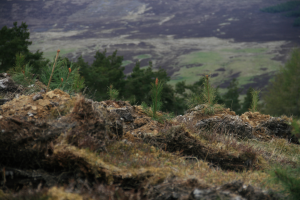Andrew Heald reports from the FSC General Assembly in Seville.
Andrew Heald is Technical Director for Confor (Confederation of Forest Industries) and is based in Edinburgh.
If I tell people that I work in forestry, I get a fairly standard response, to which I reply “No I don’t work for the Forestry Commission, never have – I work in the private sector” and then I used to add “You know, Terry Wogan’s pension fund, that type of thing.”
For most people commercial forestry is just that, and the mental image is of serried ranks of blanket Sitka, the Flow Country, and a low value crop mainly used for making paper.
Some of that was true thirty years ago, but the Lawson Budget of 1988, and increasing land prices rapidly put a stop to that style of forestry.
Forestry in 2015 is very different, in fact it has been very different for many years, but most people outside the sector have not noticed.
Confor recently took senior representatives from Scottish Wildlife Trust, John Muir Trust, RSPB, Tweed Valley Forum and Scottish Natural Heritage out on a forest visit to a new planting scheme near Selkirk, in the Scottish Borders. It was a fairly normal, farm-scale, new planting scheme, with about 20% open ground, over 12% native species, and the conifer element carefully designed to minimise visual impact and to be well back from any streams. The better in-bye land had been kept as grazing and rented back to the new owners of the original farmhouse.
The scheme had been over 4 years in the planning, and an extensive Environmental Impact Assessment had been carried to assess the impact on Curlew and Black Grouse populations. This is modern forestry delivering multiple benefits and having a positive impact on a range of ecosystem services, and producing a minimum of 60% construction timber. You can read more in the article in The Scotsman1.

We can all argue for days and years about what is the right solution for the uplands, without ever having tried to clarify what the problem is. So what problem are we trying to solve – is it declining biodiversity, job security, food security, timber security, climate change, carbon storage or even flood management, or is it all of them?
Everybody wants to see a balance in the uplands, for me that balance includes a lot more trees, not just conifers but a lot of natives as well. I have no desire to plough up deep peat but rather I am interested in the marginal grazing land, which could grow quality timber as part of a diverse new woodland with no fertiliser and no subsidy, just an initial grant to encourage the landowner to think beyond just sheep.
Confor recently commissioned an economic survey of Eskdalemuir forest and compared it to sheep economics. Forestry outperformed sheep considerably, and with declining CAP payments and a doubling demand for timber 2030, this gap will only get bigger.
A diverse upland landscape will be more resilient to climate change, will be better at sequestering carbon, will buffer the impact of storms and high rainfall, and it will support a wider range of biodiversity and jobs. Yes, this means change and yes, the hills will look different, but perhaps better. The challenge for our uplands is a simple one, how can they be managed to deliver the widest and best value, to the maximum number of people.
1http://www.scotsman.com/news/we-can-now-see-the-wood-for-the-trees-1-3805410
First published in The Scotsman, July 4th, 2020.
